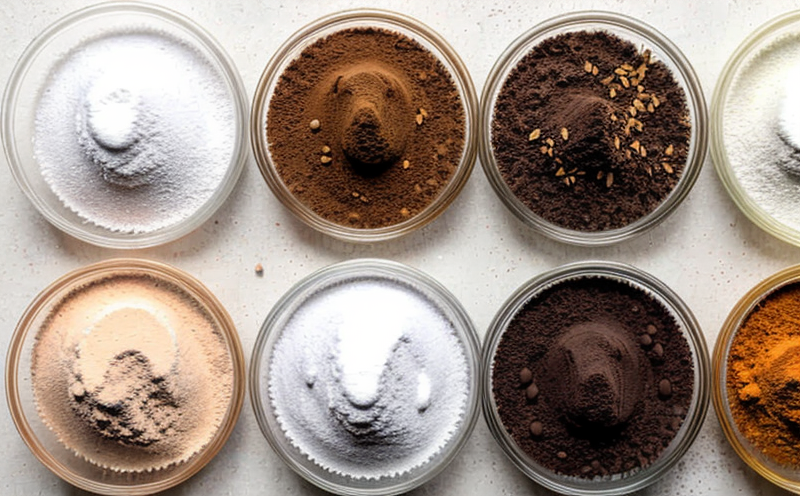AOAC 2000.03 Sunset Yellow Testing in Bakery Foods
The AOAC International Standard Method 2000.03 provides a robust and accurate means for quantifying the presence of Sunset Yellow (E110) in bakery foods, a key sweetener and colorant used extensively across the food industry. This method is essential for ensuring compliance with international regulations such as those set by the European Union and the United States Food and Drug Administration.
Sunset Yellow is widely utilized in various bakery products including cakes, pastries, and breads due to its bright yellow hue which enhances visual appeal. However, its use must be strictly controlled given potential health concerns and regulatory restrictions. The AOAC 2000.03 method allows for the precise measurement of Sunset Yellow levels, ensuring that manufacturers can meet these stringent requirements.
The testing process involves several critical steps including sample preparation, extraction, and analysis using high-performance liquid chromatography (HPLC). This ensures accurate quantification even at trace levels. The methodology is particularly important in the context of bakery food products where small variations in colorant concentrations can significantly affect product quality and consumer perception.
The significance of this method extends beyond mere compliance; it plays a pivotal role in maintaining brand reputation by ensuring consistent product quality. Regulatory bodies often inspect for adherence to these standards, making accurate testing crucial not only for legal reasons but also for maintaining market integrity.
In conclusion, the AOAC 2000.03 Sunset Yellow Testing is an indispensable tool for the food and feed industry, especially in sectors where colorants are prominently featured. By providing precise results, this method supports the development of high-quality products that meet both consumer expectations and regulatory standards.
Why It Matters
The AOAC 2000.03 Sunset Yellow Testing is a cornerstone in ensuring food safety and quality across various sectors within the bakery industry. Regulatory compliance is paramount, especially given the stringent requirements imposed by organizations like the European Food Safety Authority (EFSA) and the U.S. FDA.
- Ensures adherence to international standards
- Aids in maintaining brand reputation
- Supports product quality consistency
- Facilitates market integrity through consistent testing
Non-compliance with these regulations can lead to significant financial and reputational damage. By leveraging the AOAC 2000.03 method, food manufacturers can avoid costly recalls and potential legal issues.
The importance of this test cannot be overstated in a highly competitive market where consumers increasingly demand transparency and safety in their food choices. The method’s role is not just about compliance but also about demonstrating commitment to quality and consumer trust.
Scope and Methodology
| Aspect | Description |
|---|---|
| Samples Tested | Bakery foods including cakes, pastries, breads, and other products containing Sunset Yellow. |
| Methodology | The AOAC 2000.03 method involves sample preparation, extraction using solvents, and analysis via HPLC to quantify Sunset Yellow concentrations. |
| Reagents Used | Solvents such as acetonitrile and water are used for effective extraction. |
| Instrumentation | HPLC with a diode array detector is employed for accurate quantification. |
| Acceptance Criteria | The test results should align with the specified limits set by relevant regulatory bodies. |
| Calibration Standards | Standard solutions of Sunset Yellow are used to calibrate the HPLC instrument accurately. |
| Data Reporting | Results are reported in parts per million (ppm) or other appropriate units as defined by regulatory bodies. |
The methodology described above ensures reliable and repeatable results, making it a trusted method for testing Sunset Yellow in bakery foods. This approach not only meets the stringent requirements set forth by regulatory agencies but also supports the development of high-quality products that meet both consumer expectations and market demands.
Competitive Advantage and Market Impact
- Enhanced Compliance: Ensures strict adherence to international standards, reducing compliance risks.
- Quality Assurance: Guarantees consistent product quality across all batches, enhancing brand reputation.
- Informed Decision-Making: Provides actionable data for R&D teams to innovate and improve products.
- Consumer Trust: Demonstrates a commitment to safety and transparency, fostering consumer trust.
The ability to accurately test Sunset Yellow in bakery foods offers significant competitive advantages. Food manufacturers can differentiate their offerings by ensuring they meet or exceed regulatory standards. This not only enhances market integrity but also positions them as leaders in food safety and quality.
By leveraging this method, companies are better equipped to navigate the complexities of global regulations and market demands, ultimately leading to increased consumer satisfaction and loyalty.





